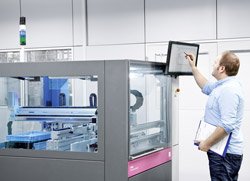
Posted to News on 14th Apr 2015, 15:23
Networked technologies for production of the future
Engineering processes are to be carried out more intuitively, faster and more efficiently in future, and the individual automation components will be more intelligent; production facilities will become more flexible and operate in networks. At the Hannover Messe, Festo and Festo Didactic are presenting initial findings from the OPAK research project and educational concepts that meet the challenges of Industry 4.0, as well as the "Multi-Carrier System" developed in cooperation with Siemens. The exhibits are rounded off by projects from the Bionic Learning Network - such as the BionicANTs, artificial insects that act in cooperation.

Production facilities are becoming more and more complex, with increased effort required for their planning and commissioning. In the OPAK research project (open engineering platform for autonomous, mechatronic automation components with a functionally oriented architecture) Festo and further partner companies are endeavouring to make this complexity controllable. Prof. Dr Peter Post, Head of Corporate Research and Technology at Festo, explains: "We are dealing with two topics in this project: on the one hand we are simplifying the engineering process and making it much more efficient; and on the other hand, we are developing components that have a digital memory - the first step along the road to intelligent components for Industry 4.0." OPAK is subsidised by the German Federal Ministry for Economic Affairs and Energy.
To make the engineering process more intuitive and efficient, a virtual emulation of the production plant is generated in OPAK. This allows all processes and functions to be simulated and tested by means of the engineering software already at the planning stage - even before the facility is actually built. The developer then only devises the desired automation processes, without having to deal with abstract commands in the programming of control units.
As a requirement for generating a virtual emulation of a production plant, the components must already incorporate all information needed for operation in their integrated controllers. In combination with adaptable interfaces that minimise the requirements for assembly, configuration and system integration, the components are thereby made suitable for "plug and produc" applications.
What is currently still being investigated and implemented on a small scale will be able to be transferred to the entire factory in the future, explains Prof. Post: "The vision behind the OPAK project is a production plant that exists in its entirety as a virtual emulation. Individual components or parts of the facility can therefore be modified or exchanged very simply, since all the processes can be virtually tested before becoming physical reality."
CPS-Gate: the first outcome of OPAK
The first outcome of the research activities in the OPAK project is the prototype of an integrated stopper module: the CPS-Gate. This unit groups together in the one component all the functions required for stopping workpiece carriers on a conveyor belt, thereby uniting PLC, sensors, actuators, RFID/NFC technology and communication functions in MES/ERP applications. In future, the CPS-Gate will be used in the CP Factory learning facility of Festo Didactic, which provides research and future-oriented training on the topic of "integrated industries".
A further example of how Festo caters already today to the requirements of Industry 4.0 in relation to products is the innovative Multi-Carrier System, a transport system devised in close cooperation with Siemens. This makes for highly flexible production processes, since it can be freely configured to suit individual requirements, and the workpiece carriers and drive units are fitted with decentralised sensors and intelligence.
Likewise, the CPX automation platform from Festo is already picking up on approaches made by integrated industries. The electric terminal for valve manifolds not only offers a connection to the field and management level, but also includes a self-adaptive servopneumatic positioning system, can perform diagnostics and is able to take on condition monitoring tasks. These systems both have an OPC UA interface for integration into Industry 4.0 HOST environments.
This year's projects from the Bionic Learning Network give us insights into the more distant future of the world of production. The BionicANTs and the eMotionButterflies demonstrate how individual systems can act in a group by means of communication, and how the real and virtual worlds can grow together. The decentralised intelligence of systems plays an important role here, along with cooperative behaviour, networking, functional integration and miniaturisation.
To find out more about the OPAK research project and the Bionic Learning Network, please visit www.festo.com.






























